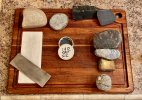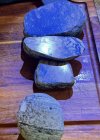- Joined
- May 29, 2004
- Messages
- 3,022
Hello,
Have you ever sharpened so much on a ceramic stone that it became dished out (concave)??? If so, you may have come to the right thread.
It was raining so I decided to resurface my kitchen knife stones.
Then it was still raining so I thought I’d grab out a few more items, take some pictures, and do a little write up…

The natural stones above (found in the area) all live on my kitchen counter and get regular use touching up our kitchen knives. Clockwise from the top left are two sandstone rocks, an unknown fine grained rock (bassalt?), a small slate stone, and then four chert stones (~equivalent to hard Arkansas stones) of varying grit. The last of those four isn’t flattened yet, but it has some very gritty surface texture that worked well for resurfacing. On the left side of the picture is my Spyderco ultra-fine ceramic and on top of that is a $9 double-sided diamond stone that I found online. Finally in the middle of the picture is a jar of 180 grit silicon carbide powder, also inexpensive and available online.
As I’ve described in a different post (“Rocks”), I like to find and flatten rocks to use as sharpening stones, and doing that with many different materials has lead me to some personal “best practices”.
I’ll start with the natural stones. Essentially, the flat surface of all stones will become clogged with steel shavings as sharpening occurs. At the same time, but to varying rates depending on many factors such as composition, hardness, etc., the stone will also exhibit some wear. In harder, finer natural stones especially, this leads to “glazing” in which the stone becomes polished and stops aggressively cutting into steel.
As stones become clogged, glazed, or dished out from use, it’s good to resurface the flat of the stone for best performance.
My general method is to vigorously scrub the edge of one stone (typically coarser) against the flat of the stone I’m resurfacing, in a cross-hatch pattern (which you can see if you look closely on the first pic and even on the two very hard stones in the middle of this picture):

Those little scratches were produced by the round rock at the bottom of the pic, using water and a little dish soap as lubricant. I just scrub away until the surface of the stone has lost most of its shine. Shiny stones generally aren’t cutting steel.
This is a quick and easy way to partially restore a stone, however to do the job more properly, or if they needed flattening, I’d take them outside and use silicon carbide (again different grits for different stones) and grind them on a paving stone with some water.
The above principles apply to most synthetic stones as well, although many of them are designed to only need flattening, as the surface is easily broken down (essentially self-resurfacing).
Lastly, the Spyderco ceramic is a different story due to the hard nature of ceramic.
After probably a decade of use on various knives (it’s a great stone) I was trying to use it on my straight razor when I was surprised to find it was no longer flat.
This prompted me to buy my first ever flat diamond stone for the primary purpose of flattening the Spyderco, which it did very well using WD-40 as lube.
This is just what I do.
I’m sure there are many other tools and methods that work, and I’m happy to hear about them if you’d like to share.
Have you ever sharpened so much on a ceramic stone that it became dished out (concave)??? If so, you may have come to the right thread.
It was raining so I decided to resurface my kitchen knife stones.
Then it was still raining so I thought I’d grab out a few more items, take some pictures, and do a little write up…

The natural stones above (found in the area) all live on my kitchen counter and get regular use touching up our kitchen knives. Clockwise from the top left are two sandstone rocks, an unknown fine grained rock (bassalt?), a small slate stone, and then four chert stones (~equivalent to hard Arkansas stones) of varying grit. The last of those four isn’t flattened yet, but it has some very gritty surface texture that worked well for resurfacing. On the left side of the picture is my Spyderco ultra-fine ceramic and on top of that is a $9 double-sided diamond stone that I found online. Finally in the middle of the picture is a jar of 180 grit silicon carbide powder, also inexpensive and available online.
As I’ve described in a different post (“Rocks”), I like to find and flatten rocks to use as sharpening stones, and doing that with many different materials has lead me to some personal “best practices”.
I’ll start with the natural stones. Essentially, the flat surface of all stones will become clogged with steel shavings as sharpening occurs. At the same time, but to varying rates depending on many factors such as composition, hardness, etc., the stone will also exhibit some wear. In harder, finer natural stones especially, this leads to “glazing” in which the stone becomes polished and stops aggressively cutting into steel.
As stones become clogged, glazed, or dished out from use, it’s good to resurface the flat of the stone for best performance.
My general method is to vigorously scrub the edge of one stone (typically coarser) against the flat of the stone I’m resurfacing, in a cross-hatch pattern (which you can see if you look closely on the first pic and even on the two very hard stones in the middle of this picture):

Those little scratches were produced by the round rock at the bottom of the pic, using water and a little dish soap as lubricant. I just scrub away until the surface of the stone has lost most of its shine. Shiny stones generally aren’t cutting steel.
This is a quick and easy way to partially restore a stone, however to do the job more properly, or if they needed flattening, I’d take them outside and use silicon carbide (again different grits for different stones) and grind them on a paving stone with some water.
The above principles apply to most synthetic stones as well, although many of them are designed to only need flattening, as the surface is easily broken down (essentially self-resurfacing).
Lastly, the Spyderco ceramic is a different story due to the hard nature of ceramic.
After probably a decade of use on various knives (it’s a great stone) I was trying to use it on my straight razor when I was surprised to find it was no longer flat.
This prompted me to buy my first ever flat diamond stone for the primary purpose of flattening the Spyderco, which it did very well using WD-40 as lube.
This is just what I do.
I’m sure there are many other tools and methods that work, and I’m happy to hear about them if you’d like to share.
Last edited:


